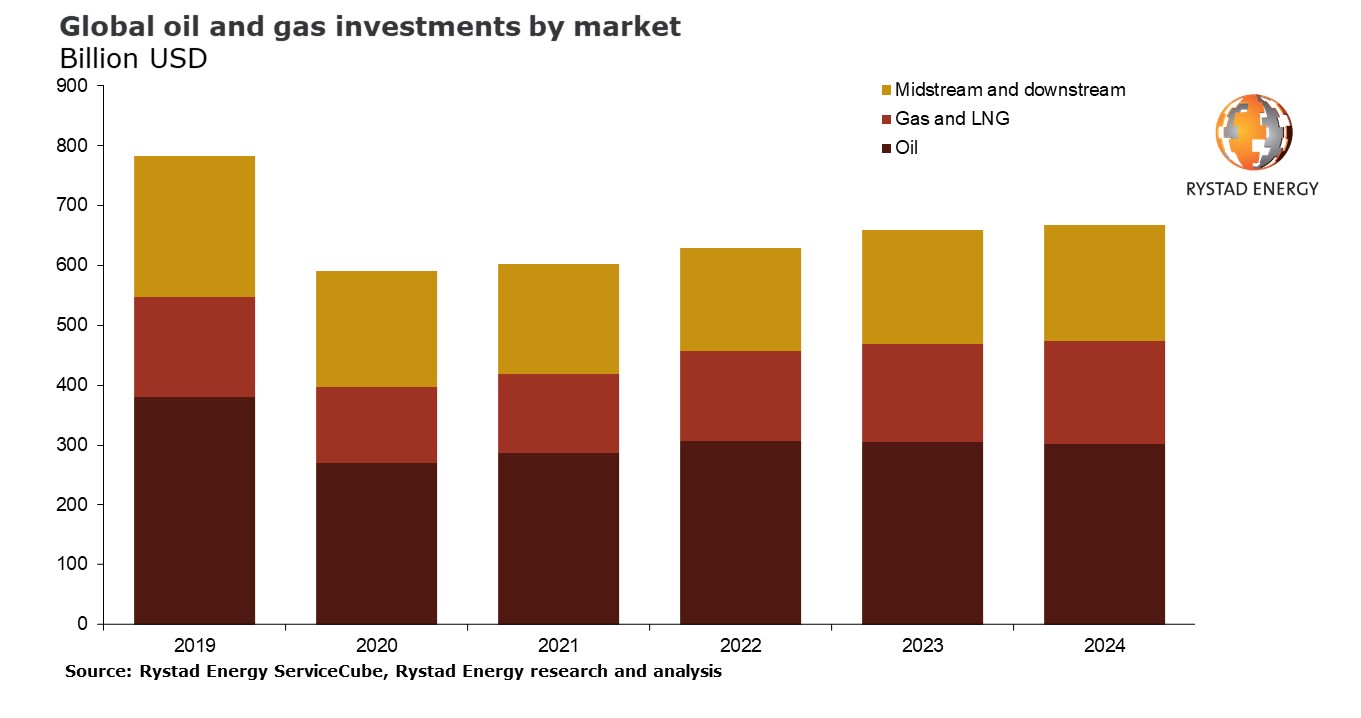
Oil and Gas investments to hit $628 billion in 2022, led by upstream gas and LNG
Global oil and gas investments will expand by $26 billion this year as the industry continues its protracted recovery from the worst of the pandemic and the hurdles imposed by the Omicron variant. An analysis by Rystad Energy projects overall oil and gas investments will rise 4% to $628 billion this year from $602 billion in 2021.
A significant factor behind the increase is a 14% increase in upstream gas and LNG investments. These segments will be the fastest-growing this year, with a jump in investments from $131 billion in 2021 to around $149 billion in 2022. Although this falls short of pre-pandemic totals, investments in the sector are expected to surpass 2019 levels of $168 billion in just two years, reaching $171 billion in 2024.
Upstream oil investments are projected to rise from $287 billion in 2021 to $307 billion this year, a 7% increase, while midstream and downstream investments will fall by 6.7% to $172 billion this year.
“The pervasive spread of the Omicron variant will inevitably lead to restrictions on movement in the first quarter of 2022, capping energy demand and recovery in the major crude-consuming sectors of road transport and aviation. But despite the ongoing disruptions caused by Covid-19, the outlook for the global oil and gas market is promising,” says Audun Martinsen, head of energy service research at Rystad Energy.

Drilling further into the numbers, global shale investments are forecasted to surge 18% in 2022, reaching $102 billion in 2022 compared with $86 billion in 2021. Offshore investments are set to increase 7%, from $145 billion to $155 billion, while conventional onshore will jump 8%, from $261 billion to $290 billion.
Regionally, Australia and the Middle East stand out, with Australia likely to see a jump in investments of 33%, thanks to greenfield gas developments. In the Middle East, investments will rise by an anticipated 22% this year as Saudi Arabia boosts its oil export capacity and Qatar expands production and export capacity of liquefied natural gas (LNG).
This year’s investment growth is very much pre-programmed by the $150 billion worth of greenfield projects sanctioned in 2021, up from $80 billion in 2020. Sanctioning activity in 2022 is likely to closely match 2021 levels, with a similar amount of project spending to be unleashed over the short to medium term.
Sanctioning activity is set to rebound in North America, with over $40 billion worth of projects due for sanctioning in 2022. Six LNG projects are expected to receive the green light, five in the United States and one in Canada. Offshore projects will also provide ample opportunities for contractors as TotalEnergies’ North Platte project enters the final stage of its tender process and LLOG Exploration’s Leon and Chevron’s Ballymore developments in the US Gulf of Mexico look to proceed to the development phase in 2022. For Africa, however, 2022 is expected to be another quiet year with expected sanctioned projects worth a comparatively small $5 billion.
When it comes to offshore field sanctioning, there are around 80 projects worth a total of $85 billion in the global approvals pipeline for 2022. Of these, 10 are floating production storage and offloading units (FPSO), 45 involve subsea tiebacks, and 35 are grounded platforms. Latin America and Europe will be responsible for around 24% each of the total offshore sanctioning values next year, with deepwater expansions expected in Guyana and Brazil and Norway following recent tax changes.
The number of sanctioned offshore projects is expected to rise year-over-year but will remain little changed when measured by capital commitments. An outstanding concern for 2022 is execution challenges related to the pandemic and increased inflationary costs for steel and other input factors. These are likely to make operators mildly cautious regarding significant capital commitments. In addition, major offshore operators are being challenged on their portfolio strategy as the energy transition unfolds, with many exploration and production companies already directing investment budgets to low-carbon energy sources.
For offshore contractors, the energy transition could be advantageous for wind power developments. Spending in the offshore wind sector reached almost $50 billion last year, double the 2019 levels. By 2025, we expect offshore wind investments will rise to $70 billion as demand for clean energy surges. By contrast, the offshore oil and gas sector is set to face a challenging energy transition period with oil demand likely to peak in the next five years, capping offshore investment at about $180 billion in 2025.
Information Source: Read More
Oil and gas, press , | Energy, Climate, Renewable, Wind, Biomass, Sustainability, Oil Price, LPG, Solar, Electric,

